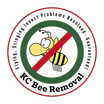Call: 913-440-4703 KC Metro Area
FAQs: Pollinator Problems
Got too many bees (or yellow jackets) around?
Pollinators, such as bees, are attracted to nectar, sap, and pollen found on flowers, trees, and bushes. As flower nectar becomes scarce in August, these pollinators resort to your sweet drink, sweet substance, and sweet-smelling trash cans as their last resort. However, indiscriminate spaying of poison is not an effective way to manage pollinators.
The time of year to eliminate yellow jackets around your outdoor spaces is the spring when they feed on protein. We will work with you to prevent an issue around your outdoor spaces in the spring and early summer.
If you have bees on your hummingbird feeders, take them down and leave them down until spring when flowers become a source of nectar again. A better option would be to purchase a bee-proof feeder. Alternatively, you can wrap a section of pantihose around your current feeder, ensuring that only long-beaked hummingbirds can access the sweet nectar.
Bees in trash cans or dumpsters:
Go non-toxic and be effective in your efforts!
- Thoroughly wash down all spilled sweet substance residue at night or early morning to avoid getting scared or stung.
- Emptying trash during night hours when bees are not flying and foraging. (bees fly in daylight). If you have a nest inside a trash can or leaf bag, let us handle it so you don't take a visit to the ER.
- Keep sweet trash in tightly sealed containers or bags to restrict access --just like you keep screens on your windows and your doors shut to keep bugs out.
- Spray down area with Fischer's Bee-Quick® to repel bees.
- Dispense repellent using a garden sprayer.
- Spray with fine mist daily as needed.
- Reapply each time it has been washed off. It has a nice fragrance of essential oils, so enjoy!
- Increase application frequency and quantity as needed.
- Note: do not dilute repellent.
Cookie Policy
This website uses cookies. By continuing to use this site, you accept our use of cookies.


